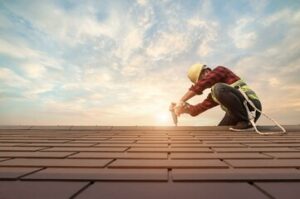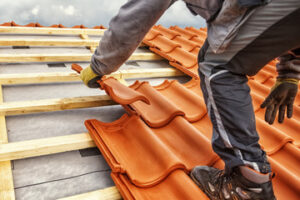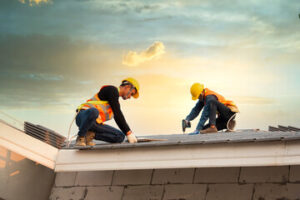Getting the maximum lifespan out of your roof requires regular maintenance and occasional repairs. Budget-conscious homeowners researching their roof issues cross their fingers that it will only require patching or repair rather than a complete replacement.

Shingles and tile are fairly easy to repair if you can locate the source of the damage. However, the type of roofing material will impact the overall cost of the project.
The roof is a critical component of any building structure, shielding the interior and its occupants from external elements such as rain, snow, sunlight, and other harsh weather conditions. It also enhances a structure’s aesthetic appeal, but it is not indestructible and may require repair or replacement from time to time. In such cases, residential roofing repair offers a proactive approach to maintenance that minimizes damage and prevents issues like leaks, missing shingles, or weakened areas from escalating into significant problems.
Many factors should be considered when selecting the best roofing materials for a building or home, including climate conditions, budget, and aesthetic preferences. Asphalt shingles, for example, are a cost-effective option that offers durability and reliability. Other popular choices include clay or concrete tiles, wood shakes or shingles, slate, and synthetic roofing materials. Each of these provides its own unique benefits and characteristics.
Leak prevention is an important aspect of residential roofing repair, and several types of sealants are available to help ensure that water does not penetrate a roof’s surface. These products can be applied with specialized tools, such as caulking guns, and are typically designed to last for many years. In addition to preventing leaks, these sealants can also improve a roof’s insulation and energy efficiency by reflecting sunlight and reducing thermal leakage.
Another important aspect of residential roofing repair is to replace aging or damaged roof components, such as flashing or vents. These components play a crucial role in keeping water and air out of a building, and repairing or replacing them can significantly reduce the need for expensive and time-consuming repairs in the future. In addition, addressing these small issues promptly can help to extend the lifespan of a roof and save homeowners from the need for premature roof replacement.
Inspection
Even a new roof can develop problems as time passes, so it’s important that it’s inspected regularly. The inspection process should include both visual observations and non-destructive moisture detection to uncover damage and prevent further leaks.
The inspector starts with a general visual observation of the surface of the roof, looking for cracks and other defects in shingles, tiles and slate; sagging in the structure; rot or decay in fascia boards or soffits; loose nails; and rust or corrosion in metal roofing materials. The inspector also checks that the correct materials were used during a replacement or installation, and that they were installed correctly. This includes making sure that shingles or roof tiles are fitted securely, that the felt is not ripped during installation, and that flashing is properly shaped to the roof.
Next, the inspector examines the materials themselves for damage or wear and tear. This includes checking for cracks and splits in shingles; bare spots and missing granules in tile and slate roofs; rusted or corroded metal in metal roofs; and moss or algae buildup in shingle or tile roofs. They will also look at the sheathing and rafters to make sure that they’re in good condition. The inspector will also check for roof valleys, which are often the source of leaks.
After the initial visual observation, the inspector should go inside to the ceilings and attic spaces of the home to check for leaks or other signs of damage. They should also check around the chimney, skylights and vents to ensure that they’re properly sealed. Finally, they should check gutters and downspouts to make sure that they’re not clogged.
Once the inspector has looked at the exterior of the roof and checked for leaks, they should use a thermal imaging camera to check the insulation inside the building. A thermal imager will highlight areas that are loosing heat, which will be apparent as bright spots on the scan. Once they have located these hot spots, they should compare them to the map they made earlier in order to identify the source of the problem.
Repair
The roof is an integral part of any building, protecting the interior from rain, snow, wind and extreme temperatures. A properly functioning roof provides peace of mind and added resale value to the home. When it becomes damaged, it can lead to leaks, pest infestations, increased energy bills, mold and mildew and loss of structural integrity. When this occurs, it is vital to repair the roof as soon as possible to avoid further damage and expensive repairs.
The repair process starts with a thorough inspection by a qualified roofer. They will examine every inch of your roof, including any problem areas, to identify the source of the issue. Then they will recommend the appropriate repair solution. They will also help you file an insurance claim if applicable.
They will start by removing any damaged shingles or other debris. Next, they will inspect the underlayment, which acts as an additional layer of protection beneath the roofing materials. Then they will replace the damaged underlayment to ensure proper waterproofing.
After the underlayment is repaired, they will reseal or replace any flashing that is necessary. They will also reseal or replace any vents or other roofing accessories that are necessary to the operation of your roof.
Before starting the actual repair work, the roofer will explain their inspection results and provide you with a detailed repair plan. They will discuss the materials needed, the estimated timeline and the cost of the repairs. This communication is crucial to ensure that you understand the current condition of your roof and the specific issues identified.
After the repair is complete, the roofer will conduct a water test to ensure that the repairs have been successful. This will help them to spot any new leaks that may develop in the future. In addition, they will clean up the work area and remove any debris from the roof and the surrounding property. They will also recommend a maintenance schedule to prevent further problems. This may include cleaning gutters, checking for loose shingles and conducting periodic inspections. This will help to extend the life of your roof and reduce repair costs in the future.
Replacement
A new roof can significantly improve a home’s value, and in some cases, is the only way to address serious leaks. The process involves removing the old shingles, felt paper and moisture barrier, and laying down brand-new materials. In addition, the roofing company may also replace or repair the decking and any other damage that’s exposed when the old shingles are removed.
The cost of a new roof depends on the type of materials, the size of the roof and any unique features such as chimneys, skylights or other fixtures. A slate, tile or metal roof will generally cost more upfront than an asphalt shingle roof, but it can last longer and add significant curb appeal to the home.
When deciding whether to repair or replace a roof, the first step is to have a professional assess the damage and determine its severity. Typically, if more than 30 percent of a roof is damaged, the roofing contractor will recommend a replacement instead of repairs.
Extensive roof damage is typically caused by a severe storm that leaves behind a lot of debris, or because the roofing material is nearing the end of its lifespan. Leaks are often the most common sign of extensive damage, but if you have a large area of missing shingles, mold growth or structural damage, it’s probably time to consider a replacement.
Moderate roof damage sometimes requires a partial replacement, but this is less costly than a full replacement. A partial replacement is especially important if the roof’s underlying structure hasn’t been compromised, and if the home’s value and appearance aren’t being affected by the damage.
Many homeowners choose to change the roof material as a way to upgrade the look of their home, and add to its overall value. Different types of roofing materials have their own benefits, including insulative properties, weather resistance and aesthetics. Some of the more popular choices include cedar shingles, concrete tiles and ethylene propylene diene terpolymer (EPDM). If you’re planning on selling your home in the future, choosing a distinctive roofing material can help it stand out from other homes on the market.


